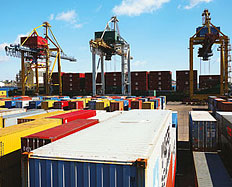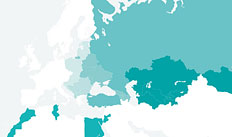COUNTRY ASSESSMENTS
Estonia
HIGHLIGHTS OF THE PAST YEAR
- Estonia showed the fastest growth of all EU countries last year. However, the rapid expansion in exports in 2011, which currently stand at 26 per cent above pre-crisis levels, could make Estonia vulnerable to negative trends in the European economy.
- Contributions into private pension funds are being gradually restored. This underlines the authorities’ commitment to a multi-pillar pension system and signals that a temporary crisis measure to restore fiscal balance can now be brought to an end.
- The division of activities of the dominant energy supplier is positive for competition and market access. The requirement for a divestment of supply activities by the current monopoly gas operator is compliant with EU directives.
KEY PRIORITIES FOR 2013
- Capacity to generate local innovation should be expanded. There is a continuing need to increase the growth of technology-intensive products. Education and innovation policies will need to be developed further towards this end.
- Credit constraints for micro, small and medium-sized enterprises (MSMEs) should be relaxed and private equity and mezzanine capital developed. Non-bank sources of finance need to be mobilised in order to facilitate the growth of innovative companies.
- The framework for public-private partnerships (PPPs) could be developed further. Estonia’s reluctance to utilise PPPs risks going without the benefits inherent in private finance. Carefully designed projects should avert fiscal risk, and could possibly be blended with EU grant funds.
MACROECONOMIC PERFORMANCE
The economy has grown at the fastest pace of any EU country, at 8.3 per cent in 2011. Respectable growth among Estonia’s main trading partners boosted exports, which rose by 27 per cent in volume terms in 2011. The main contributors to growth in industrial production (up by 16.8 per cent in 2011) were products with a higher added value, such as electronics, machinery and equipment. A clear slow-down in key export markets in the second half of 2011, and a weakening in Estonian GDP since the fourth quarter, underlined the vulnerability that stems from this export dependence. However, Estonia’s ability to mobilise domestic investment and absorb the remaining EU structural funds has led to a more modest contraction in fixed capital formation during the crisis than in most other central European economies, and a more rapid recovery since then. Private sector investment has revived, growing at 26 per cent in 2011 compared with the previous year. In parallel, due to an obligation to invest revenues from the CO2 quota trade as well as to increase the EU funds absorption before the budgeting period ends in 2013, the government remained a key driver of increasing investment activity. Unemployment has dropped from its peak in 2010 of just under 20 per cent to 10.1 per cent in mid-2012. Labour mobility with the rest of the European Union remains unusually high, and provided an important safety valve during the crisis. At the same time, this has contributed to the erosion of skilled labour available within Estonia.
Estonia’s public finances stand out as the most prudently managed in the European Union. A key goal of government policy has been to keep the budget in balance, and there are no plans to issue government bonds. Gross debt currently stands at 6 per cent of GDP, and substantial fiscal reserves have been accumulated. There were small budget surpluses in both 2010 and 2011 (sales of CO2 quotas amounted to 1.2 per cent of GDP), though the government plans to reach a deficit of about 1.5 per cent of GDP in 2012, due in part to the resumption of contributions into mandatory pension funds and in part to the environment-related investment obligations stemming from the 2011 sale of CO2 quotas.
Over the next two years Estonia’s growth will be substantially held back by weakness in European export markets. With nearly the entire banking sector being owned by foreign institutions, Estonia is exposed to the withdrawal of funding from foreign parents, which last year amounted to over 7 per cent of GDP, though the Nordic parent institutions are less exposed to funding constraints within the eurozone. So far, the contraction in credit to the private sector has been limited to the household sector, with corporate credit showing a modest expansion.
MAJOR STRUCTURAL REFORM DEVELOPMENTS
Structural reforms in Estonia are well advanced. The business environment is among the soundest in the EBRD’s countries of operations. A new anti-corruption law, passed in February 2012, is in line with efforts to underpin the country’s role as an attractive foreign investment location. According to this law, the declaration of outside interests by public officials will be more straightforward and transparent than before. Another law was passed in parliament in March 2012 to clarify the notice period in collective labour contracts, and this further strengthens labour market flexibility and transparency of contractual rights.
The government adopted a programme aimed at further boosting the country’s competitiveness. Tax revenues as a share of GDP are already well below the EU average, and a simple tax administration with extensive use of electronic submission and monitoring simplifies the system. The National Reform Programme, submitted to the European Union in April 2012, nevertheless envisages a further lowering of the tax burden to spur job creation, while preserving the current conservative fiscal approach.
Estonia remains the most knowledge-intensive economy in the transition region. High-technology goods account for about one-third of total exports to other EU countries. The country’s labour force is highly skilled relative to other transition countries, and product innovation and the digital economy are encouraged through various policy initiatives, particularly in the public sector (e-government, public health system). Comprehensive programmes have been put in place to foster education at all ages and close remaining skills gaps.
The banking sector is adapting well to the withdrawal of foreign funding. Non-performing loans are the lowest of all three Baltic countries at only about 4 per cent of total loans, as of August 2012, and households continue to reduce their outstanding debt. In line with developments elsewhere in the transition region, the government has enacted reforms to enable household debt restructuring. A new law that came into effect in April 2011 allows households with debt servicing problems to restructure their debts while avoiding bankruptcy procedures. The law foresees a case-by-case restructuring of all liabilities without the use of public funds and aims to address the remaining problems among over-indebted households.
Private sector initiatives highlight a demand for non-bank sources of funding, and more risk-oriented capital. As elsewhere in the Baltic region, private equity capital remains sparse and investment strategies are limited to growth and venture capital funds. In the 2012 budget the government approved a gradual increase of contributions in private mandatory pension funds back to the level envisaged when these funds were first set up. While diversification motives and location of fund managers will still lead to the predominant part of these funds being channelled outside the country, a limited engagement within the Baltic region may now also become possible.
The government remains sceptical about the use of public‑private partnerships. The authorities continue to regard EU structural funds as the principal source of funding to upgrade local infrastructure. In October 2011 the European Commission temporarily suspended fund disbursement due to irregularities in project oversight with government agencies. However, the problem was quickly rectified and funds are now being disbursed again.
Energy intensity remains about 75 per cent higher than the EU‑15 level. Several public investments in energy efficiency were advanced, though improving energy efficiency in residential properties and transport remains a government priority. In January 2012 the government published draft amendments to its energy legislation which aim at reducing the feed-in support for renewables, including for existing installations. This could retroactively lower the support for already operating renewable generators.
Energy sector restructuring progressed, in particular through the separation of activities in the gas sector. The operational separation of divisions in the monopoly supplier, AS Eesti Gaas, has already achieved somewhat greater transparency. In June 2012 parliament passed a law in accordance with an EU directive on the separation of distribution activities requiring Eesti Gaas to divest its grid network within three years. The operator, which is majority owned by German E.On. and Russian Gazprom, has threatened arbitration against this move. While the immediate acquirer may well be a state entity, in the medium term this measure could ensure greater competition by allowing access to alternative suppliers.







